Disconnect the negative terminal from the battery.
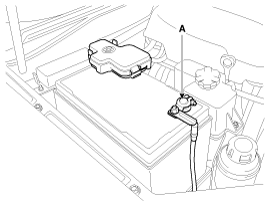
Use fender covers to avoid damaging painted surfaces.
To avoid damaging the cylinder head, wait until the engine coolant temperature drops below normal operating temperature before removing it.
When handling a metal gasket, take care not to fold the gasket or damage the contact surface of the gasket.
To avoid damage, unplug the wiring connectors carefully while holding the connector portion.
Mark all wiring and hoses to avoid misconnection.
Turn the crankshaft pulley so that the No. 1 piston is at top dead center.
Disconnect the negative terminal from the battery.

Remove the engine cover (A).
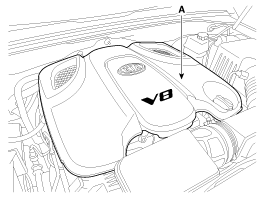
Loosen the drain plug (A) and drain the engine coolant.

Remove the radiator cap (A) to speed draining.
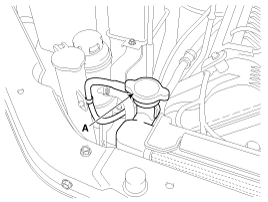
Never remove the radiator cap when the engine is hot. Serious scalding could be caused by hot fluid under high pressure escaping from the radiator.
Remove the air duct (A) and the air cleaner assembly (B).
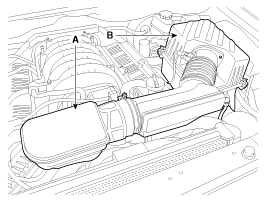
Disconnect the radiator upper hose (A) and lower hose (B).
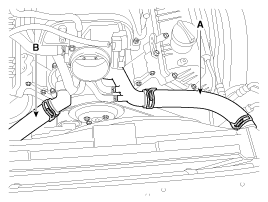
Disconnect the heater hoses (A), the fuel hose (B) and the purge control solenoid valve (PCSV) hose (C).
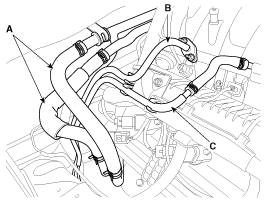
Remove the cooling fan (A).
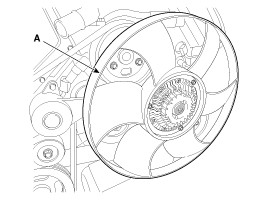
Remove the cooling fan clutch (A).
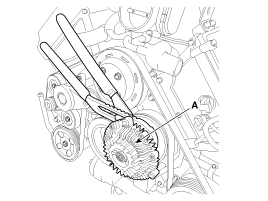
Remove the cooling fan clutch (A) after fixing the cooling fan pulley (B) by inserting a pin (C) into the hole of it.
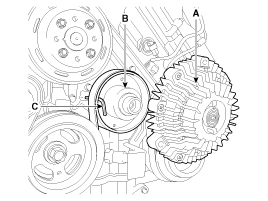
Turn the tensioner (B) clockwise and loosen, then remove the drive belt (A).
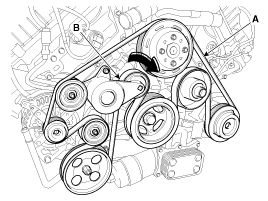
Remove the drive belt tensioner (A).
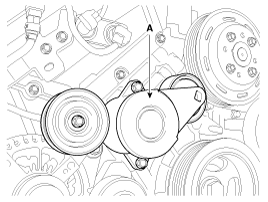
Remove the engine wiring harness from the cylinder head.
Disconnect the water temperature sensor connector (A) and the CVVT oil control valve connectors (B).
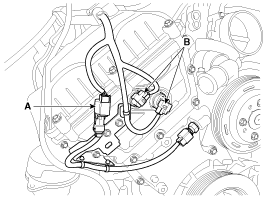
Disconnect the ETC module connector (A).
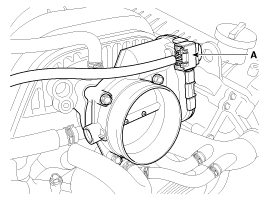
Disconnect the PCSV connector (A) and the injector connectors (B).
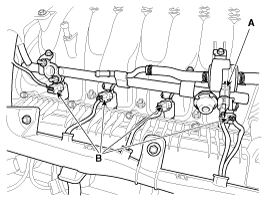
Disconnect the ignition coil connectors (A) and the wiring harness protector (B).
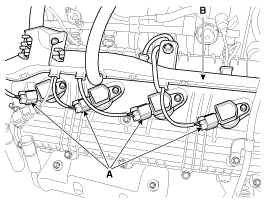
Disconnect the knock sensor connectors (A), the camshaft position sensor connectors (B), the oxygen sensor connector (C) and the condenser connector (D).
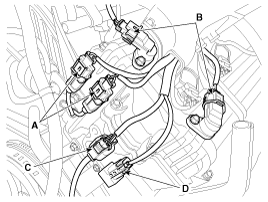
Disconnect the variable intake system solenoid valve connector (A) and the wiring harness protector (B).
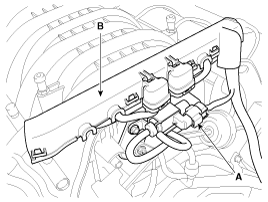
Disconnect the knock sensor connectors (A), the camshaft position sensor connectors (B), the crankshaft position sensor connector (C), the oxygen sensor connector (D) and the condenser connector (E).
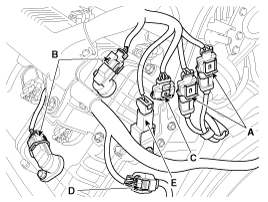
Disconnect the injector connectors (A).
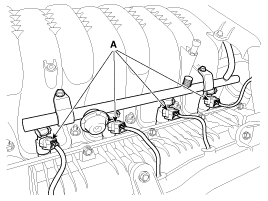
Disconnect the ignition coil connectors (A) and the wiring harness protector (B).
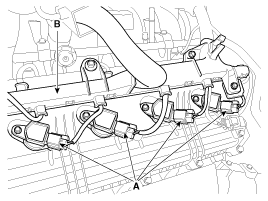
Disconnect the oil pressure switch connector (A), the CVVT oil control valve connectors (B) and the air conditioner compressor switch connector (C).
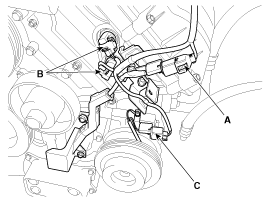
Remove the oil level gauge (A).
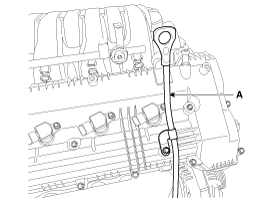
Disconnect the oxygen sensor connector (A) and remove the oxygen sensor connector bracket (B).
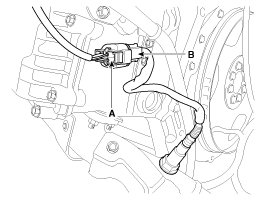
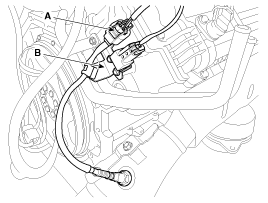
Remove the exhaust manifold heat protector (A).
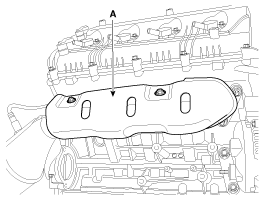

Remove the exhaust manifold (A).
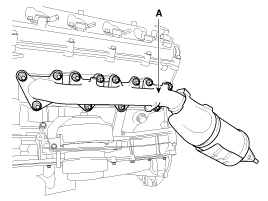
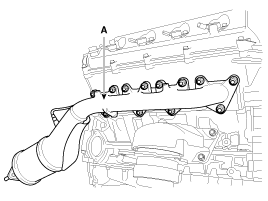
Disconnect the PCV hose (A), the PCSV hose (B) and the water hoses (C) from the intake manifold module and the throttle body.
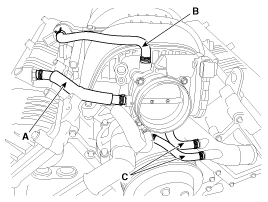
Remove the intake manifold module (A).
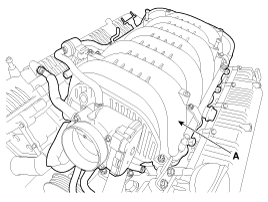
Remove the knock sensors (A).
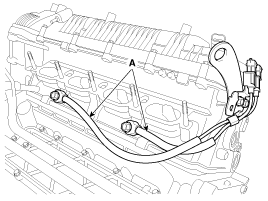
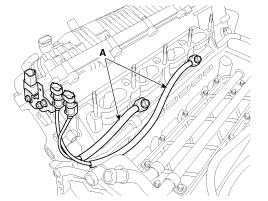
Remove the ignition coils (A).
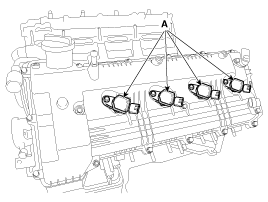
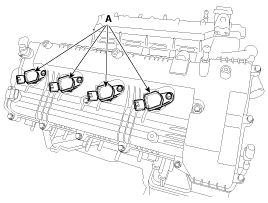
Remove the cylinder head cover (A).
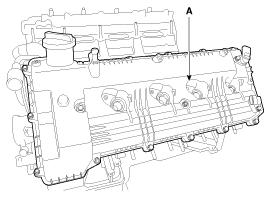
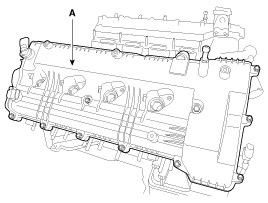
Remove the cylinder head cover gasket (A) and oil seal (B).
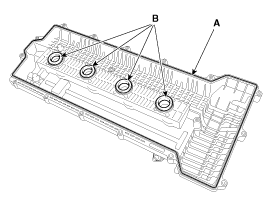
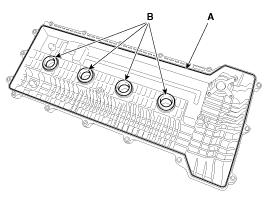
Remove the oil pressure switch wiring assembly and bracket (A).
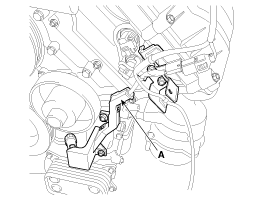
Remove the water temperature sensor wiring assembly and bracket (A).
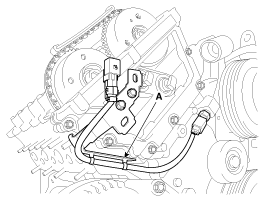
Remove the timing chain upper cover (A).
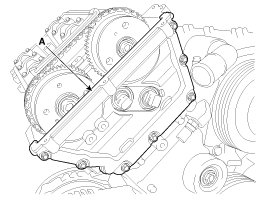
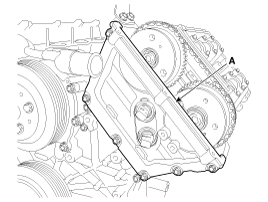
Remove the timing chain upper cover oil seal (A).
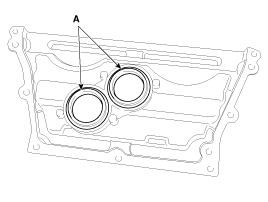
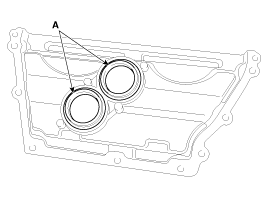
Remove the oil control valve (A).
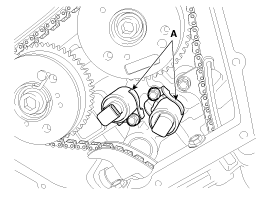
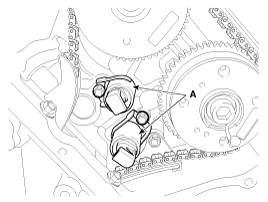
Do not reuse the OCV when dropped.
Keep the OCV clean.
Do not hold the OCV sleeve (A) during servicing.
When the OCV is installed on the engine, do not move the engine while holding the OCV yoke.
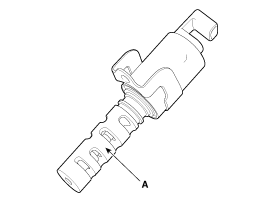
Remove the cam to cam guide (A).
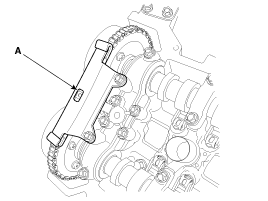
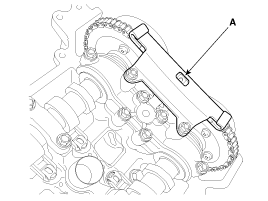
Align the timing mark of camshaft sprocket.
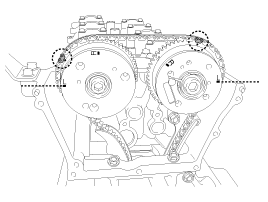
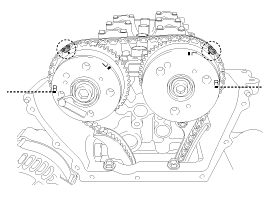
In case that the timing system has been disassembled wholly, the timing chain can be installed with all of chain installation mark of the sprocket and timing marked chain links aligned without additional marking. However, in case of on-vehicle repair (for cylinder head assembly, timing chain tensioner, CVVT, camshaft, HLA or etc.), which is not necessary to remove the timing chain completely, mark the timing chain links corresponding to the chain installation marks on the sprocket with an identification when the No.1 piston is at TDC position because it is very difficult to align all of the chain installation mark of the sprocket and the timing marked chain links.
Remove the alternator (A).
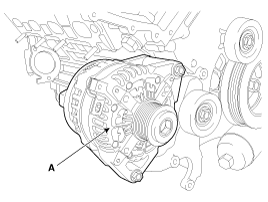
Remove the water outlet pipe (A) and the water inlet pipe (B).
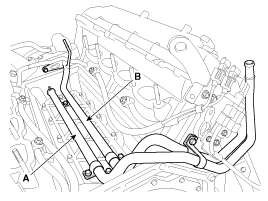
Remove the drain plug (A) and drain the engine coolant.
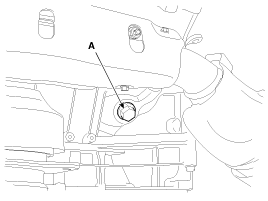
Remove the water temperature control assembly (A) and the water outlet fitting assembly (B).
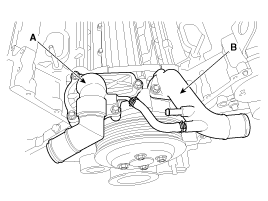
Remove the timing chain tensioner (A).
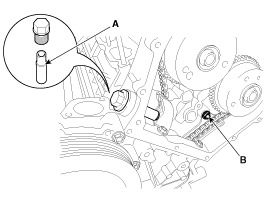

Remove the camshaft bearing caps (A) and the camshaft thrust bearing cap (B).
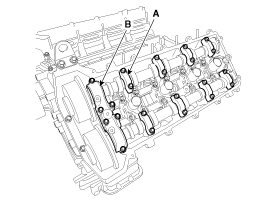
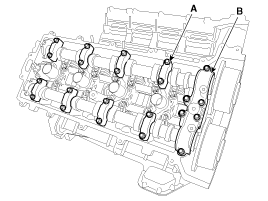
Remove the camshaft and CVVT assembly (A).
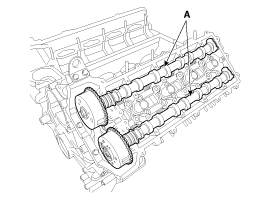
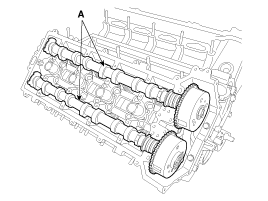
Remove the roller finger follower and the hydraulic lash adjuster assembly (A).
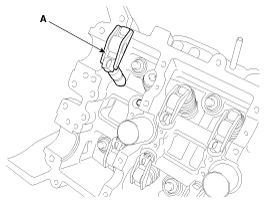
Remove the cylinder head (A).
Uniformly loosen and remove the cylinder head bolts, in several passes, in the sequence shown.
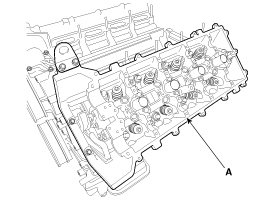
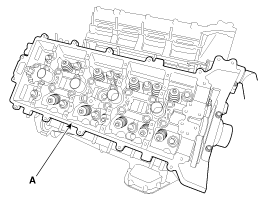
Head warpage or cracking could result from removing bolts in an incorrect order.
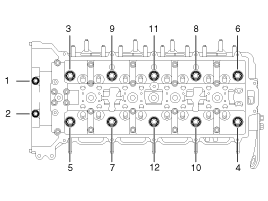
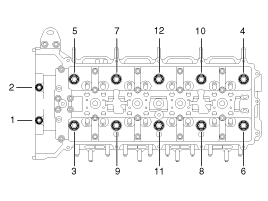
Lift the cylinder head from the dowels on the cylinder block and place the cylinder head on wooden blocks on a bench.
Be careful not to damage the contact surfaces of the cylinder head and cylinder block.
Remove the cylinder head gasket (A).
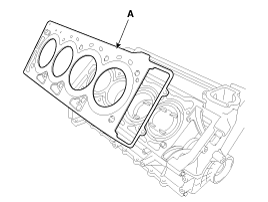
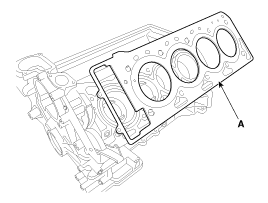
Remove the roller finger follower and the hydraulic lash adjuster assembly (A).

Remove the valves.
Using the SST(09222-3K000, 09222-3C300), compress the valve spring and remove retainer lock.
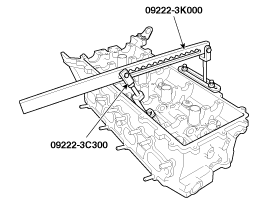
Remove the spring retainer.
Remove the valve spring.
Remove the valve.
Remove the valve stem seal.
Do not reuse old valve stem seals.
Remove the OCV filter(A).
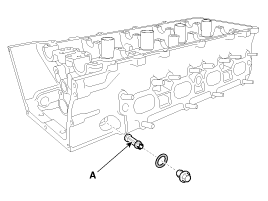
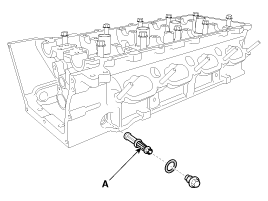
Remove the pressure relief valve.
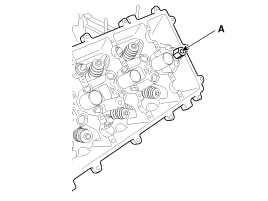
Inspect for flatness.
Using a precision straight edge and feeler gauge, measure the surface contacting cylinder block and the manifolds for warpage.
Flatness of cylinder head gasket surface
Standard : Less than 0.05mm(0.002in)
[Less than 0.02mm(0.0008in)/100x100]
Flatness of manifold gasket surface
Standard : Less than 0.1mm(0.004in)
[Less than 0.03mm(0.0012in)/110x110]
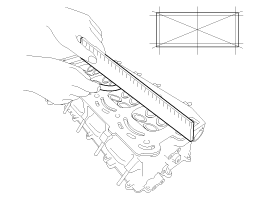
Inspect for cracks.
Check the combustion chamber, intake ports, exhaust ports and cylinder block surface for cracks. If cracked, replace the cylinder head.
Inspect valve stems and valve guides.
Using a caliper gauge, measure the inside diameter of the valve guide.
Valve guide I.D.
Intake / Exhaust :
6.000 ~ 6.012mm (0.2362 ~ 0.2367in)
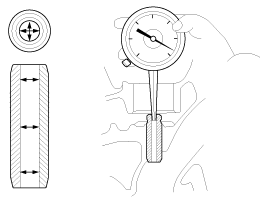
Using a micrometer, measure the diameter of the valve stem.
Valve stem O.D.
Intake : 5.965 ~ 5.980mm (0.2348 ~ 0.2354in)
Exhaust : 5.958 ~ 5.970mm (0.2346 ~ 0.2350in)
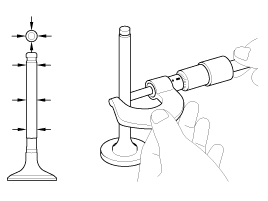
Subtract the valve stem diameter measurement from the valve guide inside diameter measurement.
Valve stem-to-guide clearance
Intake : 0.020 ~ 0.047mm (0.0008 ~ 0.0018in)
Exhaust : 0.030 ~ 0.054mm (0.0012 ~ 0.0021in)
Inspect valves.
Check the valve is ground to the correct valve face angle.
Valve face angle :
Intake/Exhaust : 45.25˚~ 45.75˚
Check that the surface of the valve for wear. If the valve face is worn, replace the valve.
Check the valve head margin thickness. If the margin thickness is less than minimum, replace the valve.
Margin
Intake : 1.2mm (0.0472in)
Exhaust : 1.2mm (0.0472in)
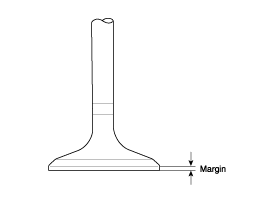
Check the valve length.
Length
Intake : 107.77mm (4.2429in)
Exhaust : 107.75mm (4.2421in)
Check the surface of the valve stem tip for wear.If the valve stem tip is worn, replace the valve.
Inspect valve seats.
Check the valve seat for evidence of overheating and improper contact with the valve face.
If the valve seat is worn, replace cylinder head.
Before reconditioning the seat, check the valve guide for wear. If the valve guide is worn, replace cylinder head.
Recondition the valve seat with a valve seat grinder or cutter. The valve seat contact width should be within specifications and centered on the valve face.
Valve seat contact width :
Intake : 1.15 ~ 1.45mm (0.0453 ~ 0.0571in)
Exhaust : 1.35 ~ 1.65mm (0.0531 ~ 0.0650in)
Valve seat angle :
Intake/Exhaust : 44.75˚~ 45.10˚
Inspect valve springs.
Using a steel square, measure the out-of-square of the valve spring.
Using vernier calipers, measure the free length of the valve spring.
Valve spring
Free height : 47.8mm (1.8819in)
Out-of-square : 1.5˚
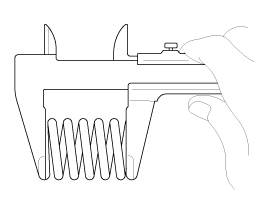
Inspect cam lobes.
Using a micrometer, measure the cam lobe height.
Cam height
Intake : 41.6mm (16.4in)
Exhaust : 41.5mm (16.3in)
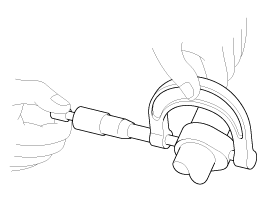
If the cam lobe height is less than standard, replace the camshaft.
Inspect the camshaft journal clearance.
Clean the bearing caps and camshaft journals.
Place the camshafts on the cylinder head.
Lay a strip of plastigage across each of the camshaft journals.
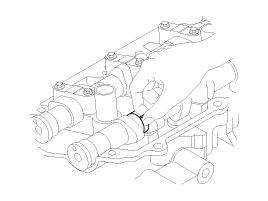
Install the bearing cap (A) and thrust bearing cap (B) with specified torque.
Tightening torque :
1st step :
6.9 ~ 7.8N.m ( 0.7 ~ 0.8kgf.m, 5.1 ~ 5.8lb-ft)
2nd step :
13.7 ~ 14.7N.m (1.4 ~ 1.5kgf.m, 10.1 ~ 10.8lb-ft)
Do not turn the camshaft.


Remove the bearing caps.
Measure the plastigage at its widest point.
Camshaft bearing oil clearance
Intake/Exhaust :
No.1 journal :
0.025 ~ 0.057mm (0.0010 ~ 0.0022in)
No.2, 3, 4, 5 journal :
0.020 ~ 0.057mm (0.0008 ~ 0.0022in)
Camshaft journal outer diameter
Intake/Exhaust :
No.1 journal :
35.964 ~ 35.980mm (1.4159 ~ 1.4165in)
No.2, 3, 4, 5 journal :
25.964 ~ 25.980mm (1.0222 ~ 1.0228in)
Camshaft journal bore inner diameter
Intake/Exhaust :
No.1 journal :
36.005 ~ 36.021mm (1.4175 ~ 1.4181in)
No.2, 3, 4, 5 journal :
26.000 ~ 26.021mm (1.0236 ~ 1.0244in)
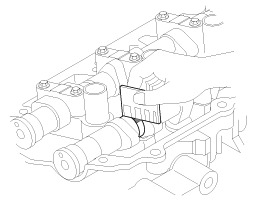
If the oil clearance is greater than maximum, replace the camshaft. If necessary, replace cylinder head.
Completely remove the plastigage.
Remove the camshafts.
Inspect the camshaft end play.
Install the camshafts.
Install the bearing cap (A) and thrust bearing cap (B) with specified torque.
Tightening torque :
1st step :
6.9 ~ 7.8N.m ( 0.7 ~ 0.8kgf.m, 5.1 ~ 5.8lb-ft)
2nd step :
13.7 ~ 14.7N.m (1.4 ~ 1.5kgf.m, 10.1 ~ 10.8lb-ft)


Using a dial indicator, measure the end play while moving the camshaft back and forth.
Camshaft end play :
0.12 ~ 0.22mm (0.0047 ~ 0.0086in)
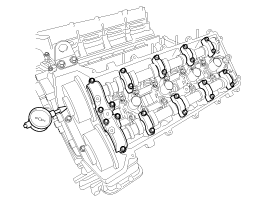
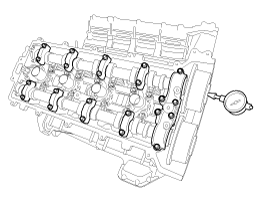
If the end play is greater than maximum, replace the camshaft. If necessary, replace cylinder head.
Remove the camshafts.
Inspect the CVVT for smooth rotation.
Clamp the camshaft using a vise. Be careful not to damage the cam lobes and journals in the vise.
Check that the CVVT is locked by turning it clockwise or counterclockwise. It must not rotate.
Intake CVVT : Seal one of the two advance holes in the camshaft journal with tape.
Exhaust CVVT : Seal one of the two retard holes in the camshaft journal with tape.
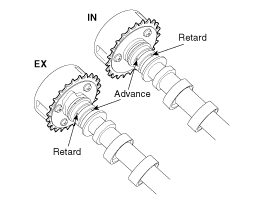
Intake CVVT : Apply approx. 150 kPa (1.5 kgf/㎠, 21 psi ) of compressed air into the unsealed advance hole to release the lock.
Exhaust CVVT : Apply approx. 150 kPa (1.5 kgf/㎠, 21 psi ) of compressed air into the unsealed retard hole to release the lock.
Cover the oil paths with a piece of cloth when applying compressed air to prevent oil from spraying.
Intake CVVT : With compressed air applied, rotate the CVVT into the advance direction (counterclockwise) within its phasing range and check that the CVVT turns smoothly.
Exhaust CVVT : With compressed air applied, rotate the CVVT into the retard direction (clockwise) and check that the CVVT turns smoothly.
CVVT phasing range
Intake : 22.5˚±1˚ (from the most retarded position to the most advanced position)
Exhaust : 22.5˚±1˚ (from the most advanced position to the most retarded position)
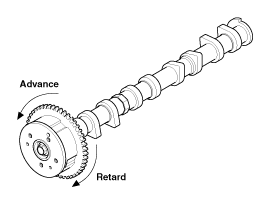
Intake CVVT : Rotate the CVVT into the most retarded position (clockwise) and then check that the CVVT is locked.
Exhaust CVVT : Rotate the CVVT into the most advanced position (counterclockwise) and then check that the CVVT is locked.
With the HLA filled with engine oil, hold A and press B by hand. If B moves, replace the HLA.
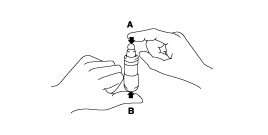
Problem | Possible cause | Action |
1. Temporary noise when starting a cold engine | Normal | This noise will disappear after the oil in the engine reaches the normal pressure. |
2. Continuous noise when the engine is started after parking more than 48 hours. | Oil leakage of the high pressure chamber on the HLA, allowing air to get in. | Noise will disappear within 15 minutes when engine runs at 2000-3000 rpm.If it doesn’t disappear, refer to step 7 below. |
3. Continuous noise when the engine is first started after rebuilding cylinder head. | Insufficient oil in cylinder head oil gallery. | |
4. Continuous noise when the engine is started after excessively cranking the engine by the starter motor or band. | Oil leakage of the high-pressure chamber in the HLA, allowing air to get in.Insufficient oil in the HLA. | |
5. Continuous noise when the engine is running after changing the HLA. | caution Do not run engine at a speed higher than 3000 rpm, as this may damage the HLA. | |
6. Continuous noise during idle after high engine speed. | Engine oil level too high or too low. | Check oil level.Drain or add oil as necessary. |
Excessive amount of air in the oil at high engine speed. | Check oil supply system. | |
Deteriorated oil. | Check oil quality.If deteriorated, replace with specified type. | |
7. Noise continues for more than 15 minutes. | Low oil pressure. | Check oil pressure and oil supply system of each part of engine. |
Faulty HLA. | Remove the cylinder head cover and press HLA down by hand.If it moves, replace the HLA. warning Be careful with the hot HLAS. |
Thoroughly clean all parts to be assembled.
Before installing the parts, apply fresh engine oil to all sliding and rotating surfaces.
Replace oil seals with new ones.
Install the OCV filter(A).
Tightening torque :
53.9 ~ 63.7Nm(5.5 ~ 6.5kgf.m, 39.8 ~ 47.0lb-ft)


Install the valves.
Using the SST(09222-28200), push in a new oil seal.
Do not reuse old valve stem seals.
Incorrect installation of the seal could result in oil leakage past the valve guides.
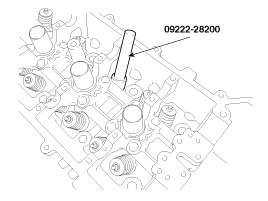
Install the valve, valve spring and spring retainer.
Place valve springs so that the side coated with enamel faces toward the valve spring retainer and then install the retainer.
Using the SST(09222 - 3K000, 09222-3C300), compress the spring and install the retainer locks. After installing the valves, ensure that the retainer locks are correctly in place before releasing the valve spring compressor.

Lightly tap the end of each valve stem two or three times with the wooden handle of a hammer to ensure proper seating of the valve and retainer lock.
Install the roller finger follower and the hydraulic lash adjuster assembly (A).

Until installing HLA shall be held upright so that engine oil in HLA should not spill and assured that dust does not adhere to HLA.
HLA shall be inserted tenderly to the cylinder head not to spill engine oil from HLA. In case of spilling, air vent shall be done in accordance with the air bent procedure.
Stroke HLA in engine oil 4~5 times by pushing its cap while pushing the ball down slightly by hard steel wire.
(Take care not to severely push hard steel wire down since ball is several grames.)
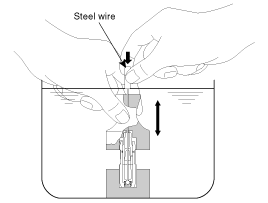
Install the pressure relief valve.
Tightening torque :
21.6 ~ 25.5Nm (2.2 ~ 2.6kgf.m, 15.9 ~ 18.8lb-ft)

Thoroughly clean all parts to be assembled.
Always use a new head and manifold gasket.
The cylinder head gasket is a metal gasket. Take care not to bend it.
Rotate the crankshaft, set the No.1 piston at TDC.
Install the cylinder head gasket (A).
The sealant locations on cylinder head gasket, cylinder block and timing chain lower case must be free of engine oil and ETC.
Before assembling the cylinder head gasket, the liquid sealant TB 1217H should be applied on the gap between cylinder block and timing chain lower case.
The part must be assembled within 5 minutes after sealant was applied.
Refer to below illustration to apply the sealant.
Bead width :
3.5 ~ 4.5 mm (0.1378 ~ 0.1772 in)
Sealant locations :
1.5 ~ 2.5mm (0.0591 ~ 0.0984 in)
from timing chain lower case inner surface
Recommended sealant : Liquid sealant TB1217H
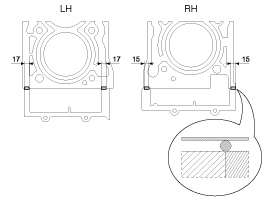
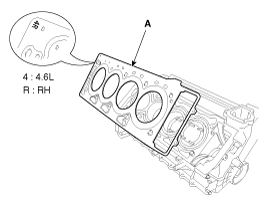
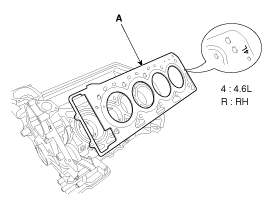
Apply sealant on cylinder head gaskets after assembling cylinder head gaskets on cylinder block.
The part must be assembled within 5 minutes after sealant was applied.
Be careful of the installation direction.
Install the cylinder head.
Remove the extruded sealant after assembling cylinder heads.


Install the cylinder head bolts.
Do not apply engine oil on the threads and under the heads of the cylinder head bolts.
Using SST(09221-4A000), install and tighten the cylinder head bolts and plate washers, in several passes, in the sequence shown.
Tightening torque :
Cylinder head bolts (1~10) :
32.4 ~ 36.3N.m(3.3 ~ 3.7kgf.m, 23.9 ~ 26.8lb-ft) + 88˚~92˚+ 118˚~122˚
Flange bolts (11~12) :
32.4 ~ 36.3N.m(3.3 ~ 3.7kgf.m, 23.9 ~ 26.8lb-ft)
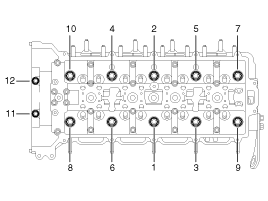
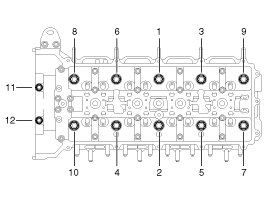
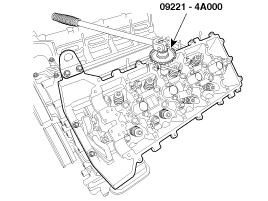
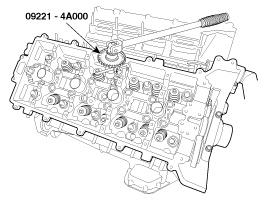
Install the CVVT assembly.
Tightening torque :
73.5 ~ 83.4N.m(7.5 ~ 8.5kgf.m, 54.2 ~ 61.5lb-ft)
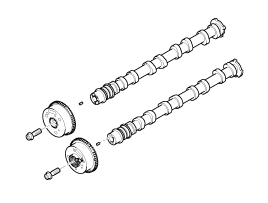
Install camshaft to dowel pin of CVVT assembly.At this time, attend not to be installed to oil hole of camshaft.
Hold the hexagonal head wrench portion of the camshaft with a vise, and install the bolt and CVVT assembly.
Do not rotate CVVT assembly when camshaft is installed to dowel pin of CVVT assembly.
Install the roller finger follower and the hydraulic lash adjuster assembly (A).

Install the LH/RH camshaft assembly (A).


Apply a light coat of engine oil on camshaft journals.
Assemble the timing mark of CVVT to the same level of cylinder head top surface.
Be careful the right, left bank, intake, exhaust side before assembling.
Turn the crankshaft to set the No.1 piston at TDC position.
Install the timing chain to the camshaft sprocket.


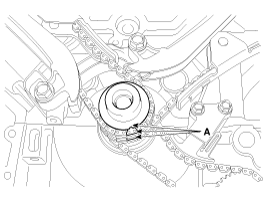
Make sure the crankshaft is at TDC position.
Align the chain installation mark (A) of the crankshaft sprocket and the timing mark (A) of the chain link, and then install the chain.
In case of marking the timing chain links corresponding to the chain installation marks on the sprocket with an identification for on-vehicle repair (for cylinder head assembly, timing chain tensioner, CVVT, camshaft, HLA or etc.), align all of the chain installation mark of the sprocket and the timing marked chain links for reassembly.
To install the timing chain with no slack between each shaft (cam, crank), follow the below procedure.
Crankshaft sprocket → Timing chain guide → Exhaust camshaft sprocket → Intake camshaft sprocket. (LH Bank)
Crankshaft sprocket → Timing chain guide → Intake camshaft sprocket → Exhaust camshaft sprocket. (RH Bank)
When reassembling the timing chain, make sure all of the chain installation mark of the sprocket and the timing marked chain links are aligned.
Install the camshaft bearing caps and the camshaft thrust bearing cap.


Tighten the bolts in order to below sequence.
Tightening torque :
1st step :
6.9 ~ 7.8N.m ( 0.7 ~ 0.8kgf.m, 5.1 ~ 5.8lb-ft)
2nd step :
13.7 ~ 14.7N.m (1.4 ~ 1.5kgf.m, 10.1 ~ 10.8lb-ft)
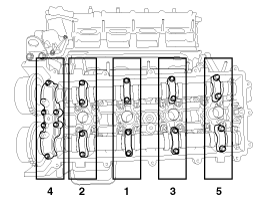
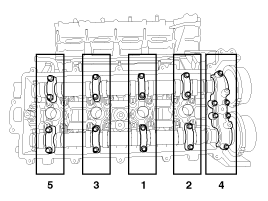
Be careful the right, left bank, intake, exhaust side before assembling.
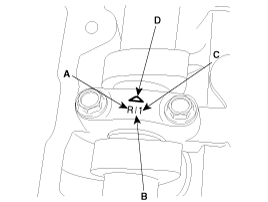
A : L(LH),R(RH)
B : I(Intake), E(Exhaust)
C : Journal number
D : Front mark
Be sure to install the thrust bearing cap and bearing cap bolts in the correct places.
Install the cam to cam guide (A).
Tightening torque :
9.8 ~ 11.8Nm (1.0 ~ 1.2kgf.m, 7.2 ~ 8.7lb-ft)


Install the LH timing chain guide bolt (B) and then the LH timing chain tensioner (A).
Install the timing chain tensioner & plug bolt in the hole on the cylinder head by hand.
Tighten the plug bolt with the specified torque while pressing the timing chain on the LH intake CVVT.
Tightening torque :
Timing chain guide bolt :
21.6 ~ 25.5Nm (2.2 ~ 2.6kgf.m, 15.9 ~ 18.8lb-ft)
Timing chain tensioner plug bolt :
78.5 ~ 88.3N.m(8.0 ~ 9.0kgf.m, 57.9 ~ 65.1lb-ft)
Do not reuse the timing chain tensioner.
Make sure the timing chain tensioner is at compressed transport position state.
Install the timing chain tensioner with the oil hole facing the plug bolt.
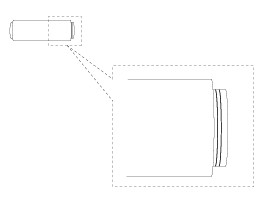

Install the RH timing chain guide bolt (B) and then the RH timing chain tensioner (A).
Install the timing chain tensioner & plug bolt in the hole on the cylinder head by hand.
Tighten the plug bolt with the specified torque while pressing the timing chain on the RH intake CVVT.
Tightening torque :
Timing chain guide bolt :
21.6 ~ 25.5Nm (2.2 ~ 2.6kgf.m, 15.9 ~ 18.8lb-ft)
Timing chain tensioner plug bolt :
78.5 ~ 88.3N.m(8.0 ~ 9.0kgf.m, 57.9 ~ 65.1lb-ft)
Do not reuse the timing chain tensioner.
Make sure the timing chain tensioner is at compressed transport position state.
Install the timing chain tensioner with the oil hole facing the plug bolt.
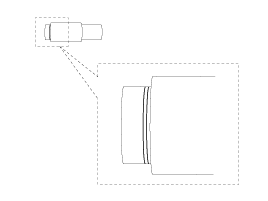

Set tension of the timing chain tensioner.
LH Bank
Press the timing chain on the LH intake CVVT by hand with the timing mark “L” on the LH intake and exhaust CVVT and the LH cylinder head upper surface aligned.
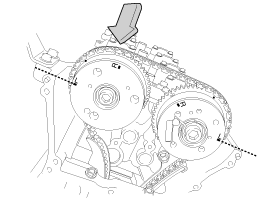
To set tension of the timing chain tensioner, push the timing chain tensioner arm outward with a force about 150N (15.3kgf, 33.7lbf).
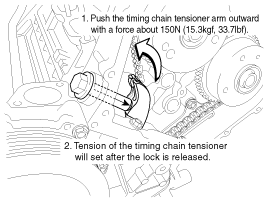
To check the tension of the timing chain tensioner, push the timing chain tensioner arm outward strongly. The distance between the cylinder head surface and end of tensioner plunger should be about 20mm (0.79inch).
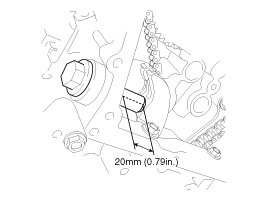
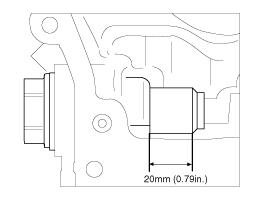
RH Bank
To align the timing mark “R” on the RH intake and exhaust CVVT and the RH cylinder head upper surface, turn the exhaust CVVT about 20˚ counterclockwise while pressing the timing chain on the intake CVVT by hand with all of the chain installation mark of the sprocket and the timing marked chain links aligned.
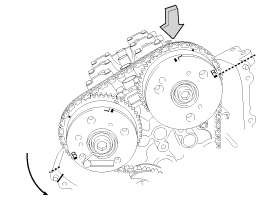
To set tension of the timing chain tensioner, push the timing chain tensioner arm outward with a force about 150N (15.3kgf, 33.7lbf).
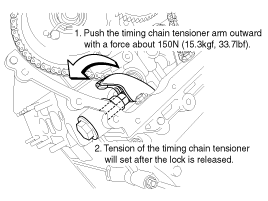
To check the tension of the timing chain tensioner, push the timing chain tensioner arm outward strongly. The distance between the tensioner body and end of tensioner plunger should be about 3.5mm (0.14inch).
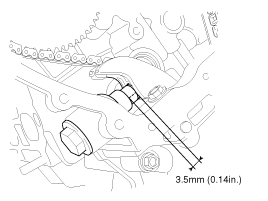
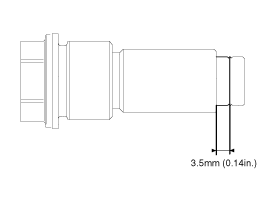
After setting tension of the LH, RH timing chain tensioner, check timing again.
Make sure the chain installation mark of the sprocket and the timing marked chain links are aligned.
Rotate the crankshaft 2 revolutions in regular direction (clockwise viewed from front), confirm the timing marks on the LH, RH intake and exhaust CVVT and the RH cylinder head upper surfaces are aligned.
After rotating the crankshaft 2 revolutions in regular direction (clockwise viewed from front), confirm the timing mark.
Always turn the crankshaft clockwise.
Turning the crankshaft counter clockwise before building up oil pressure in the hydraulic timing chain tensioner may result in the chain disengaging from the sprocket teeth.
Install the water temperature control assembly (A) and the water outlet fitting assembly (B) with new O-ring and new gasket.
Tightening torque :
16.7 ~ 19.6N.m (1.7 ~ 2.0kgf.m, 12.3 ~ 14.5lb-ft)

Install the water outlet pipe (A) and the water inlet pipe (B).
Tightening torque :
9.8 ~ 11.8Nm (1.0 ~ 1.2kgf.m, 7.2 ~ 8.7lb-ft)
Use new O-rings when reassembling.
Never apply sort of oil on O-ring and O-ring groove of pipe end.
O-ring must be free from scratching damage.
Make clean the contact face before assembly.
Insert pipe after to be wetting O-ring or inside of attaching hole by water or antifreeze.

Install the drain plug (A).
Tightening torque :
96.1~100.0N.m(9.8~10.2kgf.m,70.9~73.8lb-ft)

Install the alternator (A).
Tightening torque :
29.4 ~ 41.2N.m (3.0 ~ 4.2kgf.m, 21.7 ~ 30.4lb-ft)

Install the oil control valve(OCV) (A).
Tightening torque :
9.8 ~ 11.8N.m ( 1.0 ~ 1.2kgf.m, 7.2 ~ 8.7lb-ft)


Do not reuse the OCV when dropped.
Keep the OCV clean.
Do not hold the OCV sleeve (A) during servicing.
When the OCV is installed on the engine, do not move the engine while holding the OCV yoke.

Use the SST (09231-2J500, 09231-H1100) install the timing chain upper cover oil seal (A).
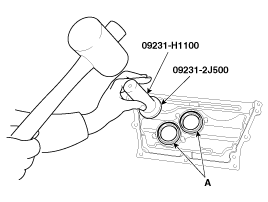
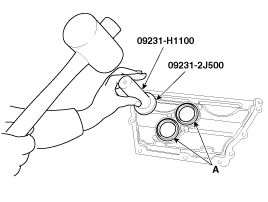
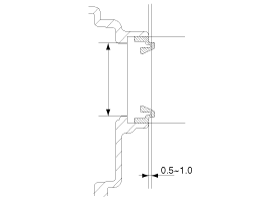
Apply sealant to the timing chain upper cover.
Using a gasket scraper, remove all the old packing material from the gasket surfaces.
Before assembling the timing chain upper cover, the liquid sealant TB1217H or LT5900H should be applied on upper cover.
The part must be assembled within 5 minutes after the sealant was applied.
Bead width : Ø2.5 ± 0.5mm(0.1 ± 0.002in)
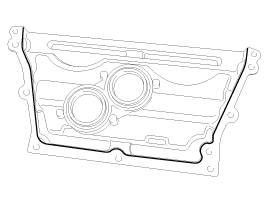
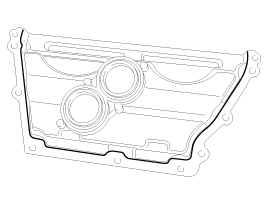
Clean the sealing face before assembling two parts.
Remove harmful foreign materials on the sealing face before applying sealant.
When applying sealant gasket, sealant must not protrude into the inside of upper cover.
To prevent leakage of oil, apply sealant gasket to the inner threads of the bolt holes.
Install the timing chain upper cover (A).
Tightening torque :
9.8 ~ 11.8Nm (1.0 ~ 1.2kgf.m, 7.2 ~ 8.7lb-ft)


Install the water temperature sensor wiring assembly and bracket (A).
Tightening torque :
Wiring bracket bolts :
9.8 ~ 11.8Nm (1.0 ~ 1.2kgf.m, 7.2 ~ 8.7lb-ft)
Water temperature sensor :
19.6 ~ 39.2Nm (2.0 ~ 4.0kgf.m, 14.5 ~ 28.9lb-ft)

Install the oil pressure switch wiring assembly and bracket (A).
Tightening torque :
Wiring bracket bolts :
9.8 ~ 11.8Nm (1.0 ~ 1.2kgf.m, 7.2 ~ 8.7lb-ft)
Oil pressure switch :
14.7 ~ 21.6Nm ( 1.5 ~ 2.2kgf.m, 10.8 ~ 15.9lb-ft)

Use the SST (09231-2J500, 09231-H1100), install the oil seal (B) and the gasket (A).
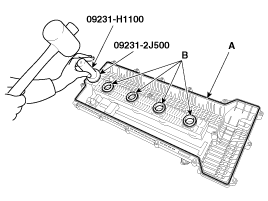
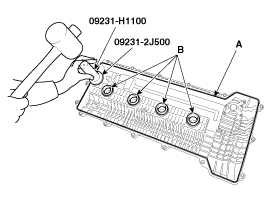
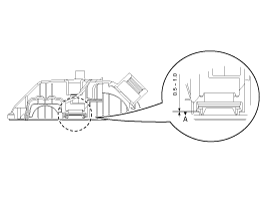
Install the cylinder head cover.
The sealant locations on cylinder head and timing chain upper case must be free of engine oil and ETC.
Before assembling the cylinder head cover, the liquid sealant TB 1217H or LT5900H should be applied on the gap between cylinder head and timing chain upper case.
The part must be assembled within 5 minutes after sealant was applied.
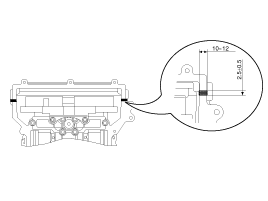
Install the cylinder head cover (A).
The part must be assembled within 5 minutes after sealant was applied.
Tightening torque :
1st step : 4.9 ~ 5.9N.m (0.5 ~ 0.6kgf.m, 3.6 ~ 4.3lb-ft)
2nd step : 9.8 ~ 11.8N.m (1.0 ~ 1.2kgf.m, 7.2 ~ 8.7lb-ft)


Tighten the cylinder head cover bolts as following method.
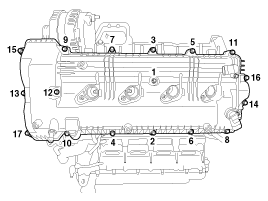
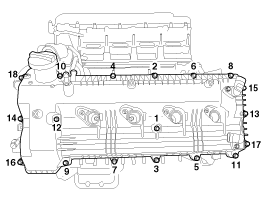
Install the ignition coils (A).
Tightening torque :
9.8 ~ 11.8N.m (1.0 ~ 1.2kgf.m, 7.2 ~ 8.7lb-ft)


Install the knock sensors (A).
Tightening torque :
14.7 ~ 24.5N.m, 1.5 ~ 2.5kgf.m, 10.9 ~ 18.1lb-ft)


Install the intake manifold module (A) tighten the nuts as following method.
Tightening torque :
1st step :
4.9 ~ 7.8N.m ( 0.5 ~ 0.8kgf.m, 3.6 ~ 5.8lb-ft)
2nd step :
19.6 ~ 26.5N.m ( 2.0 ~ 2.7kgf.m, 14.5 ~ 19.5lb-ft)

Tighten the intake manifold nuts as followig method.
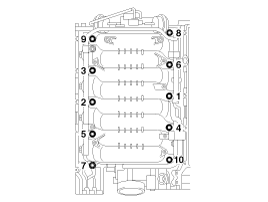
Reconnect the PCV hose (A), the PCSV hose (B) and the water hoses (C) to the intake manifold module and the throttle body.

Install the exhaust manifold (A) tighten the nuts as following method.
Tightening torque :
49.0 ~ 53.9N.m (5.0 ~ 5.5kgf.m, 36.2 ~ 39.8lb-ft)
The “TOP”mark of the gasket must be face the exhaust manifold.


Tighten the exhaust manifold nuts as followig method.
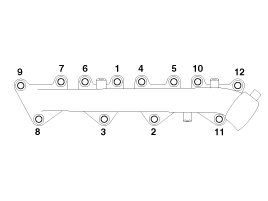
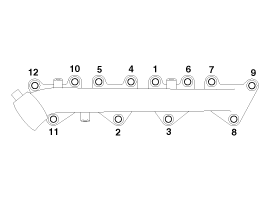
Install the exhaust manifold heat protector (A).
Tightening torque :
8.8 ~ 10.8 N.m ( 0.9 ~ 1.1kgf.m, 6.5 ~ 8.0lb-ft)


Reconnect the oxygen sensor connector (A) and Install the oxygen sensor connector bracket (B).


Install the oil level gauge (A).
Tightening torque :
9.8 ~ 11.8Nm (1.0 ~ 1.2kgf.m, 7.2 ~ 8.7lb-ft)

Install the engine wiring harness to the cylinder head.
Reconnect the water temperature sensor connector (A) and the CVVT oil control valve connectors (B).

Reconnect the ETC module connector (A).

Reconnect the PCSV connector (A) and the injector connectors (B).

Reconnect the ignition coil connectors (A) and the wiring harness protector (B).

Reconnect the knock sensor connectors (A), the camshaft position sensor connectors (B), the oxygen sensor connector (C) and the condenser connector (D).

Reconnect the variable intake system solenoid valve connector (A) and the wiring harness protector (B).

Reconnect the knock sensor connectors (A), the camshaft position sensor connectors (B), the crankshaft position sensor connector (C), the oxygen sensor connector (D) and the condenser connector (E).

Reconnect the injector connectors (A).

Reconnect the ignition coil connectors (A) and the wiring harness protector (B).

Reconnect the oil pressure switch connector (A), the CVVT oil control valve connectors (B) and the air conditioner compressor switch connector (C).

Install the drive belt tensioner (A).
Tightening torque :
19.6 ~ 23.5N.m (2.0 ~ 2.4kgf.m, 14.5 ~ 17.4lb-ft)

Turn the tensioner (B) clockwise and loosen, then install the drive belt (A).

Install the cooling fan clutch (A).
Tightening torque :
58.8N.m (6.0kgf.m, 43.4lb-ft)

Install the cooling fan clutch (A) after fixing the cooling fan pulley (B) by inserting a pin (C) into the hole of it.

Install the cooling fan (A).
Tightening torque :
8.8 ~ 13.7Nm (0.9 ~ 1.4kgf.m, 6.5 ~ 10.1lb-ft)

Reconnect the heater hoses (A), the fuel hose (B) and the purge control solenoid valve (PCSV) hose (C).

Reconnect the radiator upper hose (A) and lower hose (B).

Install the air duct (A) and the air cleaner assembly (B).
Tightening torque :
9.8 ~ 11.8Nm (1.0 ~ 1.2kgf.m, 7.2 ~ 8.7lb-ft)

Install the engine cover (A).

Reconnect the negative terminal to the battery.

Refill engine oil.
Clean the battery posts and cable terminals with sandpaper assemble them, then apply grease to prevent corrosion.
Inspect for fuel leakage.
After assembling the fuel line, turn on the ignition switch (do not operate the starter) so that the fuel pump runs for approximately two seconds and fuel line pressurizes.
Repeat this operation two or three times, then check for fuel leakage at any point in the fuel lines.
Refill radiator and reservoir tank with engine coolant.
Bleed air from the cooling system.
Start engine and let it run until it warms up. (Until the radiator fan operates 3 or 4 times.)
Turn Off the engine. Check the level in the radiator, add coolant if needed. This will allow trapped air to be removed from the cooling system.
Put radiator cap on tightly, then run the engine again and check for leaks.